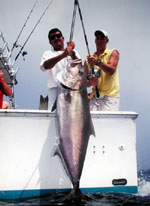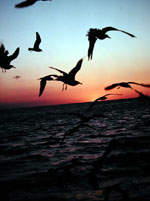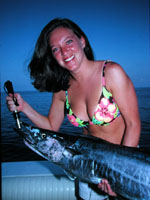
|
Features
|
|
|
|
Books
|
|
|
|
Fun & Games
|
|
|
|
Contact Us
|
|
|
John's Journal... Entry 149, Day 4
BOB EPSTEIN ON VACATION PHOTOS
Five Tips For Shooting Better Digital Photography For The Outdoors
 EDITOR'S
NOTE: Bob Epstein of River Ranch, Florida, has worked as a professional
photographer and outdoor writer for years. He also represents Olympus
Cameras. He speaks throughout the nation on how to take better outdoor
photographs. This week, Epstein will tell us all how to take better vacation
and outdoors photography.
EDITOR'S
NOTE: Bob Epstein of River Ranch, Florida, has worked as a professional
photographer and outdoor writer for years. He also represents Olympus
Cameras. He speaks throughout the nation on how to take better outdoor
photographs. This week, Epstein will tell us all how to take better vacation
and outdoors photography.
* All digital cameras work on the same principle -- they save images when you depress the shutter. The image you make is saved in tiny dots called dpi (dots per inch.) Digital cameras with a higher number dpi make sharper pictures with fewer spaces between the dots so the image has a clearer and more life-like, natural appearance. You can buy a digital camera for $50 that has fewer dpi than say a $300 or $1000 camera with higher capability expressed in mega pixels (millions of little pixels.) The dots per inch are not as important when sending the image on the internet. In fact, it's better to send images on the internet through e-mail with fewer dots per inch because it takes longer to load more dots per inch, and time is a factor when your downloading a picture or image file. The more-expensive digital cameras with more dots per inch are best for printing images that look more like a Kodak moment photograph.
 *
Most digital cameras have three quality modes -- super-high definition,
high definition and standard definition. The Smart Media cards, the Sony
Sticks and the Compact Flash saving disks save more on standard definition
settings. If you're shooting for eBay or the Web, shoot at lower definitions
so you can pack more images on your disk. If you want just one, two or
perhaps three super-high images for printing, then by all means shoot
at the super-high definition mode, download for your printer, and then
delete the images because they take up your saving medium with too many
millions of pixels you don't need anymore after printing. Save them elsewhere
but not on your camera disk.
*
Most digital cameras have three quality modes -- super-high definition,
high definition and standard definition. The Smart Media cards, the Sony
Sticks and the Compact Flash saving disks save more on standard definition
settings. If you're shooting for eBay or the Web, shoot at lower definitions
so you can pack more images on your disk. If you want just one, two or
perhaps three super-high images for printing, then by all means shoot
at the super-high definition mode, download for your printer, and then
delete the images because they take up your saving medium with too many
millions of pixels you don't need anymore after printing. Save them elsewhere
but not on your camera disk.
 *
You need to buy the best digital camera that fits your budget, and don't
fret that the price or features will change very soon after you buy your
unit. I use a favorite old digital camera (4-years old) for all my Internet
imaging. I did get another higher mega-pixel camera for many of my print
images that I use for my professional work because I sell my photographs.
Most people don't sell their photos professionally, so they don't need
a heavy-priced, large mega-pixel camera.
*
You need to buy the best digital camera that fits your budget, and don't
fret that the price or features will change very soon after you buy your
unit. I use a favorite old digital camera (4-years old) for all my Internet
imaging. I did get another higher mega-pixel camera for many of my print
images that I use for my professional work because I sell my photographs.
Most people don't sell their photos professionally, so they don't need
a heavy-priced, large mega-pixel camera.
* You should get close to your subject and hold the camera steady. Keep all distracting backgrounds out of your images. This sounds like advice for film photographer. But in using a digital camera, the same techniques and thoughts have to go into composition as in film photography.
 *
The nice thing about digital photography or imaging is that the digital
image can be played with, either on your camera or by using accompanying
software that allows for adjusting the look of your image to suit you.
Whether you increase brightness, contrast, sharpness, enlargement or cropping,
you always get what you want and never have to go for film and processing
again.
*
The nice thing about digital photography or imaging is that the digital
image can be played with, either on your camera or by using accompanying
software that allows for adjusting the look of your image to suit you.
Whether you increase brightness, contrast, sharpness, enlargement or cropping,
you always get what you want and never have to go for film and processing
again.
For more information on Bob Epstein's book "How To Take Your Best Shot With A Point-and-Shoot Camera," e-mail him at bobepstein@aol.com. The book costs $4.95 with postage included.
TOMORROW: 10 Secrets For Best Vacation Photography
Check back each day this week for more Bob Epstein on Vacation Photos ...
Day 1 - Buying a Camera
Day 2 - Most Common Mistakes
Day 3 - The Joy Of A Digital Camera
Day 4 - Five Tips For Shooting Better Digital
Photography For The Outdoors
Day 5 - 10 Secrets For Best Vacation Photography